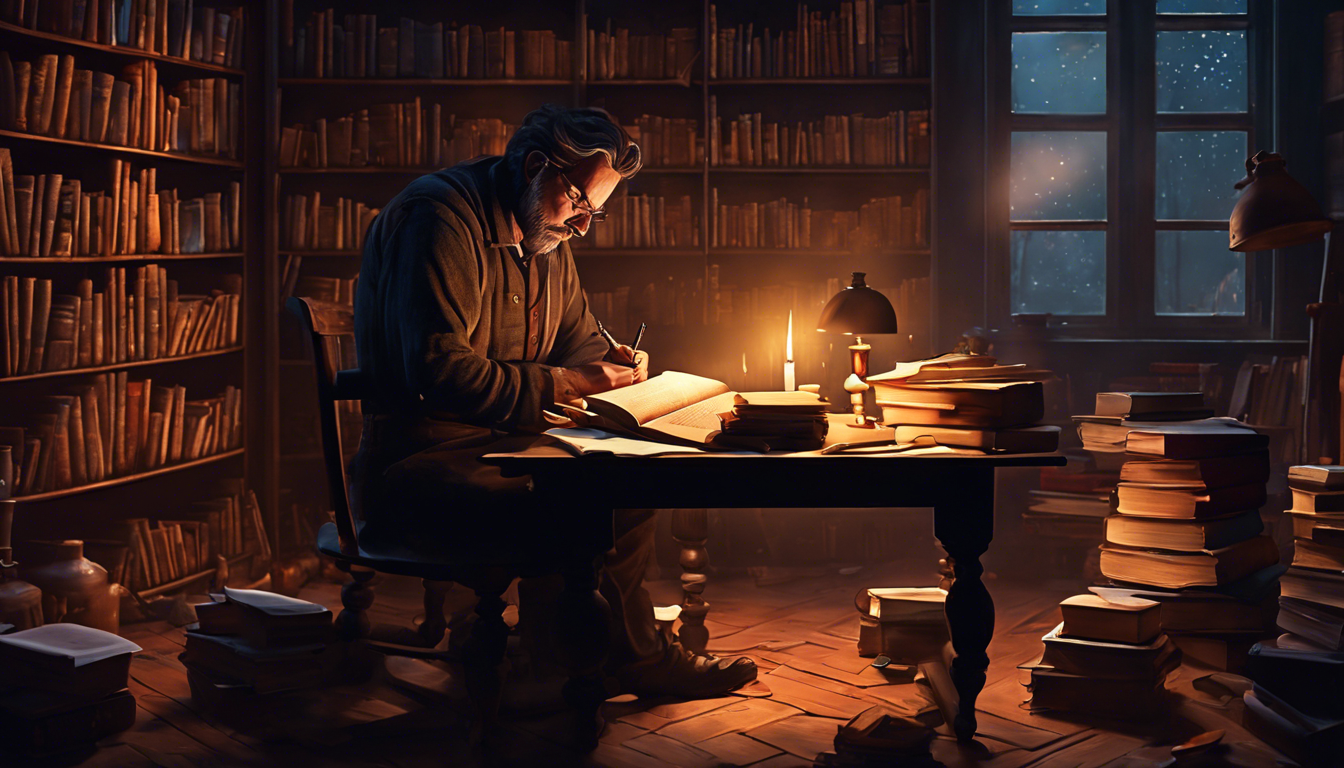
Welcome, aspiring playwrights to the enchanting realm of dramatic writing, where words leap off the page and dance like a troupe of over-caffeinated squirrels!
If you’ve ever wondered how to turn that intriguing idea rattling around in your noggin into a captivating piece of drama, you’ve come to the right place.
Grab your favorite beverage (coffee, tea, or something stronger—no judgment here) and let’s dive into the fascinating world of dramatic writing, where creating heart-plucking moments and side-splitting laughter is as easy as pie!
But hold onto your quills; we’re about to embark on a wild ride filled with characters that leap into action, plots that twist like a pretzel, and dialogue that sizzles like bacon on a Sunday morning.
Ready?
Let’s go!
The BEST AI Screenwriting Tool In Hollywood!
Key Takeaways
- Dramatic writing is crucial for creating engaging narratives that resonate with audiences.
- Key elements include conflict, stakes, and emotional engagement to drive the story forward.
- Strong character development is essential for crafting relatable and compelling protagonists and antagonists.
- A well-structured narrative follows the arc of drama, guiding the audience through a journey of tension and resolution.
- Effective dialogue not only conveys information but also enhances the drama and tension within the story.
Understanding Dramatic Writing: Definition and Importance
Ah, dramatic writing!
It’s not just a fancy term tossed around in ivory towers or whispered in hushed tones at theatricals—oh no!
It’s the spellbinding art form that adds zest, zeal, and a dash of pizzazz to storytelling.
But what exactly is dramatic writing?
In its simplest form, this craft refers to the technique of creating compelling narratives that come alive through dialogue and stage directions—think plays, screenplays, and radio dramas!
Why, you ask, should we care about it?
Well, gather ‘round, budding writers, for dramatic writing is the heartbeat of all your favorite films and theater pieces!
It’s where characters arc, conflict simmers, and resolutions bloom—like a well-timed joke at a family dinner, it captivates, entertains, and sometimes leaves you questioning your life choices.
Understanding this art form is essential for any writer looking to make their stories leap off the page (and maybe even onto the stage)!
So, grab your quill (or keyboard) and let’s embark on a riotously insightful journey into the world of dramatic writing!
Key Elements of Dramatic Writing
Dramatic writing is like a deliciously crafted sandwich; you need the right ingredients to make it scrumptiously irresistible!
First up on our dramatic menu is conflict—the spicy mustard that brings everything to life; without it, your characters may as well be sitting on a bench, twiddling their thumbs (yawn!).
Next, we have characters, the delectable fillings that can range from sweet and relatable to sour and cunning, ensuring your audience is thoroughly engaged.
Don’t forget the setting, your bread, which holds everything together and gives your story context.
Last but not least, let’s sprinkle in some dialogue—the zesty pickles that add flavor and zest to your writing, keeping the conversation flowing faster than a hot cup of coffee at a writer’s retreat.
Mastering these key elements of dramatic writing will not only elevate your storytelling but also keep your audience on the edge of their seats, eagerly awaiting the next act of your play!
‘Drama is life with the dull bits cut out.’ – Alfred Hitchcock
Character Development: Creating Relatable and Compelling Characters
Ah, character development!
It’s like the seasoning in your grandma’s secret soup recipe; without it, you’re just left with a bland broth of dramatic writing that even a hungry rat would turn its nose up at.
So, how do you craft characters that leap off the page, do the tango, and then also make you weep like a newborn?
It all starts with making them relatable.
Consider giving your characters flaws, like the tendency to trip over their own feet at the most inconvenient moments, or an obsession with collecting rubber ducks, because who doesn’t love a cute quack?
Create backstories that will make readers go, ‘Ah, that explains the rubber duck fixation!’ This will not only help readers understand their motivations but also make them invest emotionally.
Combine this relatable prowess with some compelling goals that could make even the stoic gods of Mount Olympus raise an eyebrow.
Want to take over the world?
Great!
Just make sure your character stops at the duck-themed café first.
Remember, in the great theatre of dramatic writing, it’s the unique quirks and relatable desires of your characters that will have readers cheering for the hero and tossing popcorn at the villain!
The BEST AI Screenwriting Tool In Hollywood!
Structuring Your Narrative: The Arc of Drama
Ahoy, aspiring playwrights and novelists!
If you’ve ever been venturing into the wild world of dramatic writing, you might feel like a ship adrift without a compass.
Fear not!
Let’s chart a course through the tumultuous seas of storytelling with the trusty map of the Arc of Drama.
Picture this: your narrative is like a thrilling roller coaster – it’s got those heart-pounding climbs, stomach-dropping descents, and loop-de-loops that leave you gasping for breath.
The Arc of Drama is our guide to making sure your tale isn’t just a flat line, but instead, a riveting ride that keeps readers on the edge of their seats!
So, start by establishing your characters and settings, build the tension with conflicts that are juicier than a ripe peach, and finally, let your resolution tie it all up tighter than a drum.
Now, grab that quill and remember; in dramatic writing, every word counts, and every twist and turn is a chance to create unforgettable moments!
Using Dialogue to Enhance Drama and Tension
Ah, the art of dramatic writing!
It’s like seasoning your favorite dish: a pinch of dialogue can spice things up and keep your reader from drifting off into a boring stupor.
Imagine a movie scene where the hero is silently brooding in the corner while twinkling lights glisten in the background; riveting, right?
Wrong!
Cue the dialogue!
Using snappy lines, clever banter, or even heated arguments can crank up the drama and tension levels all the way to eleven.
Think of dialogue as the fuel to your storytelling fire.
It not only gives your characters a voice—but boy does it sizzle!
So, if you want your readers to hang onto every word as if they’re watching the latest nail-biting thriller, remember that the right concoction of dramatic writing and engaging dialogue is the secret ingredient to keep hearts racing and pages turning.
Next time you sit down to write, ask yourself: ‘What would my characters spill if they were having a heart-to-heart or a fiery showdown?’ You might just find that the drama and tension you’ve been searching for is hiding in plain sight—wrapped up in your characters’ very own chatter!








